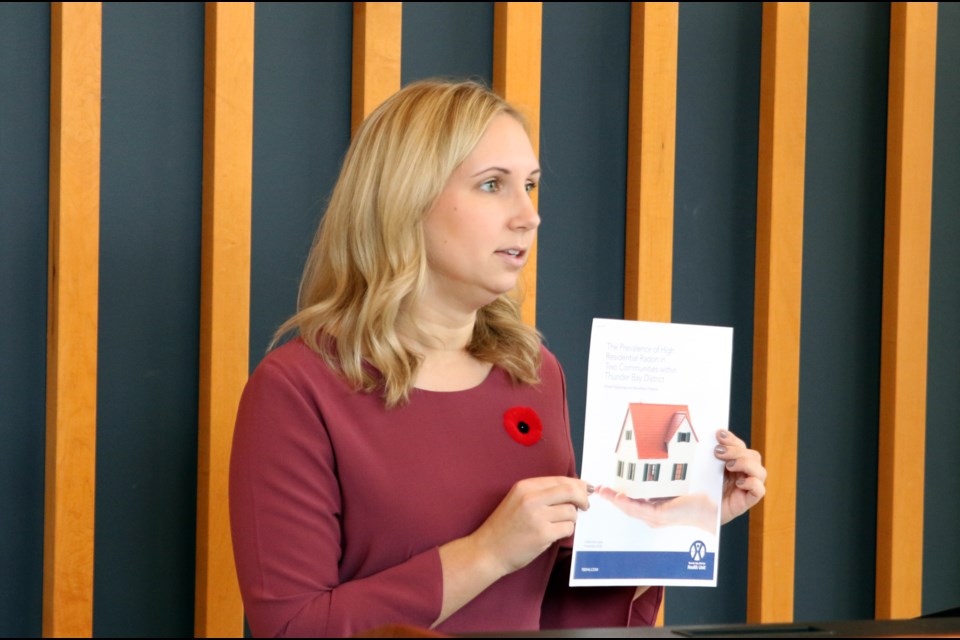THUNDER BAY - People living in Oliver Paipoonge are being encouraged to test their homes for radon, one of the leading causes of lung cancer among non-smokers in Canada.
“We do want people in Oliver Paipoonge to know that there is a good probability that you are living in a house with high radon and you should test,” said Erica Sawula, an epidemiologist at the Thunder Bay District Health Unit. “If you do test and have those high levels, take any mitigation you can.”
A recent study conducted by the Health Unit throughout 2017/2018 found 65 per cent of homes in Oliver Paipoonge have high levels of radon, or according to Health Canada’s guidelines, radon in excess of 200 becquerels per cubic metre of air. The same study found 17 per cent of homes in Marathon also have high radon levels.
“To put these results in perspective, on average across Ontario, about 5 per cent of homes have high levels of residential radon,” Sawula said.
Radon is a gas created by the breakdown of uranium in rock, water, and soil. It can enter a home in various ways, such as cracks in the foundation, exposed soil, or sump pits. Long-term exposure to radon is the leading cause of lung cancer among non-smoking Canadians.
According to Sawula, the high radon levels in Oliver Paipoonge were not necessarily unexpected. A previous study in the city of Thunder Bay found 16 per cent of homes had high radon levels, but that number climbed the further out from the city testing was conducted.
“When we did the study in the city of Thunder Bay, the wards that had more of a rural or semi-rural component had increased levels,” Sawula said. “So we were anticipating a bit, but that 65 per cent was quite troubling for us.”
Testing for radon is a simple and relatively inexpensive process, said EcoSuperior program coordinator, Caroline Cox. Testing kits can be purchased from EcoSuperior for $50.
To test a home, a testing kit should be left for at least 91 days in an area of the home where an individual spends more than four hours a day. Testing should be done during the home heating season, but the kit can be left for as long as a year.
“If your test comes back low, which most tests do, then great, you’ve done everything you need to do,” Cox said. “But if it comes back high, you really need to take steps to lower your exposure to radon gas to limit your chances of developing lung cancer.”
Steps that can be taken to reduce exposure include sealing portals of entry for radon gas, such as sump pumps or cracks in a home’s foundation.
If these steps are taken and retesting shows they have not mitigated the exposure, an active soil depressurization system can be installed. It can cost between $2,000 and $3,000, but Cox said it lowers radon exposure by 90 per cent.
To assist people living in these areas, the Health Unit and EcoSuperior will be hosting a series of workshops as part of Radon Action Month in November.
The first workshop in Oliver Paipoonge will be held at the Murillo Library on Nov. 21 from 2:30 to 4 p.m. and a second will be held on Nov. 22 from 6 to 7:30 p.m. at the Rosslyn Library.
A public health inspector will be at the Marathon Centre Mall on Nov. 22 from 4 to 7 p.m.
“It’s really easy for radon not to be on the tops of people’s minds,” Cox said. “You can’t see it, you can’t smell it, and you’re not going to notice it. But it does cause lung cancer and it causes a significant portion of lung cancer in Canada. It is really important to get the test kit, put it in your home, forget about it for 90 days, mail it in, and when you get the results, you can figure out if you need next steps or not.”
For more information about radon, visit the Thunder Bay District Health Unit Website, the EcoSuperior website, or TakeActionOnRadon.ca.
